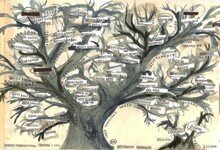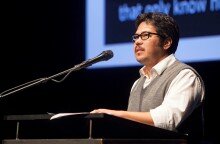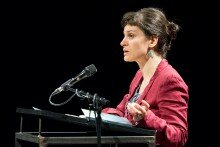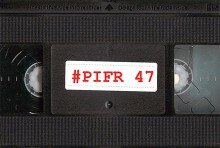Renshi: writing without a centre

Toward a new appreciation of the collaborative
During the romantic era, the notion that individuality represented the source of all new developments in the art world came to have enormous cultural influence in the West. Rather than seeing poets, writers, visual artists, composers and performers as temporally bound people working within (and often against) the bounds of their own cultures and prison-houses of language to produce their work, the romantic era tended to view artists as visionaries who dove into the depths of their individuality to present new, personal works that spoke of their vision of the world. It is no wonder then that the figure of the genius – a person who was seen as possessing an distinctive personality and mind that presented them with idiosyncratic visions different from those of everyone else’s – grew to figure so prominently in romantic concepts of art, music and literature.
Even now, in the early twenty-first century, the romantic notion of art, with its ideas of singular authorship and vision, continues to have a great pull over our contemporary imaginations. Perhaps nowhere is this more apparent than in the acclaim given to individual producers of so-called ‘high culture’. It is common to praise people as great authors, artists and poets – even geniuses – while forgetting that what we call ‘greatness’ is not just the result of natural skill and vision, but also hard work, learning, practice and honed craftsmanship. The flip side of this respect for the individual artist is that our society tends to place less value on artistic products born out of cooperative acts of creation. For instance, commercial publishers tend to shy away from co-authored books, and academia, at least in the United States, tends to place less weight upon co-authored books or (even worse) translations. In the visual art market, people assume, a piece of art is less interesting and valuable if it is not the sole product of a single individual. It is precisely for this reason that agents behind many commercially successfully visual artists who do rely on helpers tend to gloss over this fact in marketing. (For instance, it is common to see exhibitions of Dale Chihuly, Jeff Koons or Takashi Murakami which do not even mention the fact that each of these artists hands off their ideas to crews of loyal workers who execute them.)
Still, when one stops to think, what pieces of art are not collaborative in nature? Architecture requires not just an architect, but engineers and labourers to produce. Cinema involves not just a director and actors, but often casts of hundreds, if not thousands of others. Music involves a collaborative effort between composer and performers, even though sometimes they might live hundreds of years apart. Artists often rely upon advice and help of technicians, friends, or fellow artists, and even when they do not, it is still the gallery or museum curator who determines the ways an artistic work is seen and the value bestowed upon it. Writing usually involves intimate collaborations with editors. Not only do they do much of the final shaping of contents; in the end, editors are the ones who determine what exactly will be seen by the world. In addition, postmodern theory has, at least in the academy, started to change the ways people see the relationship between the individualism and art. Focusing on the flow of ideas and power relationships that structure a work, poststructuralism emphasises those aspects of creative acts that are beyond the control of the individual creator. If anything, the creator is only one focus within a network of historical and linguistic forces – one operation within the parameters of complex semiotic systems that predate the artist him- or herself.
If art is necessarily collaborative, then perhaps it is incumbent upon us to shift radically the ways that we think about ownership in the linguistic and visual arts. Perhaps it would make sense for us, as readers and consumers of culture, to celebrate collaboration between poets, novelists, translators, visual artists, musicians and performers. Perhaps it would make sense for us to seek out genres of artistic production that highlight and celebrate collaboration, not just because they present us with exciting, fresh flows of ideas, but also because they do the important work of unsettling traditional, conservative notions of intellectual proprietorship and truth.
Renshi as collaborative poetry
The argument above is a roundabout way of arguing for the value of collaborative poetic endeavours. Poetry has been a field that has been especially prone to the romantic cult of individuality, no doubt in large part due to the ideal that the poet represents a sort of ‘seer’. (In fact, this idea of poet-as-seer has roots at least as far back as Greek thought, but certainly, it took on new force in the romantic era.) Nonetheless, we should not allow this to eclipse our appreciation for other kinds of poetry that has been created through interesting and innovative forms of collaboration, especially considering how important such collaborations has been in the history of poetry around the world.
One of the most exciting, dynamic forms of contemporary collaborative poetic production today is renshi or “linked poetry” – the modern offshoot of a far older verse form known as renga (“linked songs”), which was popular in medieval and early modern Japan. In renga, poets would cooperate to write poems with fixed metrical patterns of 5-7 and 5-7-7 sound units. One poet would compose a handful of lines in these metres, then the next would pick up on themes in that opening verse to comprise another segment, and so on. In each turn, the poet would move in a slightly different direction. Although it would still honour the spirit of the earlier verse by drawing upon some theme or image in it, it would have its own unique focus or message. In his study of renga, the Japanese literary scholar Earl Miner wrote that in renga “no stanza has a continuing semantic connection, as a discrete poetic unit, with anything other than its predecessor and successor. We can choose if we like to consider it in itself. We must consider each as a fresh view of its predecessor, which it completes. And we must consider it also as the basis of the next stanza, which alters it in making a new poetic unit. It has no such connection beyond.”(1) With each verse building upon the previous one, the sequence continues until reaching a predetermined number. Still, the poets were not entirely free to do whatever they liked at each turn. Within renga, there was a series of complex rules that governed when and how different thematic elements were introduced, for example, images of the moon, the seasons, or other elements of nature.
In 1969, the Mexican poet Octavio Paz, then living in Paris, brought together a group of four poets to compose a series of linked verses based loosely on the rules of traditional Japanese verse. His partners were Jacques Roubaud from France, Edoardo Sanguineti from Italy, and Charles Tomlinson from Britain. After a fun and intense week of writing, the results were translated into all of the languages of the participants.(2) In a nod to the metrical traditions of Japanese renga, the participants wrote their work in fragments that would, when pieced together, form a series of sonnets. This innovative way of collaborating caused a small stir in the poetic world of the time, suggesting the exciting possibilities for a new kind of poetic production. Soon afterward, these poems were translated into Japanese and, ironically, helped give birth to a new style of poetry in Japan called renshi.
The character shi of the word renshi often refers more specifically to the kind of poetry that developed in the late nineteenth and twentieth centuries and that did not necessarily adhere to traditional strictures on length, rhythm, and diction. In other words, renshi differs from renga in that it is written in shi, which are relatively flexible in terms of content and poetic rules. Participants in a renshi session typically agree beforehand on the total number of verses and the number of lines each person will contribute per round. Each contribution should play off, but not adhere too closely to, the one that came before it. In other words, there should be a cognitive leap between each verse, but the verse should not be so far that it is completely unrelated. As a result, the renshi grows organically, moving in new directions, treating new subjects, and resisting attempts to pin it down too closely to one ideology or theme.
One might think of renshi perhaps as being somewhat akin to a jazz improvisation. Several players appear on stage at once, gathered for a single purpose, but the players take turns performing their solos on different instruments – usually, in the case of renshi, different types and styles of poetic writing. The first ‘performer’ might present his work using one instrument – verses written in a terse, avant-garde style perhaps – then steps into the background to let the next ‘performer’ step forward and take the stage. Within the first riff are the themes to which the second ‘performer’ creates her improvisation, which she performs using a slightly different style – perhaps verses with a more narrative quality. In a sense, the first ‘performer’ is not entirely silent through the second verse; by providing the themes for the second verse, it is almost as if he is performing the accompaniment in the background. Where renshi differs from jazz improvisations is that jazz typically involves a return to certain pre-agreed-upon key signatures and melodies, culminating in a sense of recognition and excitement when those musical elements come round again. Renshi, however, continually moves outward, treating new ideas and themes, not necessarily returning to a single point of return unless the poets desire to bring it home in such a way. In a sense, the kind of collaboration that takes place in renshi is always making new forays into the unknown.
Because renshi shifts from voice to voice – ‘instrument’ to ‘instrument’ in the analogy above – renshi may seem avant-garde and perhaps even perplexing to readers who are used to poetry written with a single overarching message or voice. Reading renshi requires a mindset different than reading poetry penned by a single person. Like older forms of Japanese linked verse, renshi do not have integral ‘plots’ that run throughout the entire work. They are “linked in a continuity at each point of juncture but are otherwise discontinuous in plot”.(3) Just as the authorship shifts from person to person at the point of juncture between poems, so the authorial voice can shift, thus changing perspective radically. Rather than considering the work overall as a single, unified work that represents the product of a single artistic drive, the reader should take each nugget of verse – each little jazz-like riff – as its own little world. Each is separate and could be considered on its own, but it is more interesting when seen in relation to what comes before and after it, rather in the way that clusters of stars are more interesting when one sees them as constellations. Renshi are not what Roland Barthes would have called “readerly texts” – ones that provide all the information necessary for readers to consume them in a passive, unthinking way; instead, renshi are “writerly texts” – writing with gaps and suggestive pauses that invite the reader to become involved by making their own sense out of the work. In this sense, renshi do not just involve creative collaboration between poets, but also between the text and reader.
In the decades since Paz organised his now famous series of linked verses, the Japanese poet Makoto Ōoka has served as a major champion of renshi. He and the poets associated with his poetry magazine Oar (Kai) have organised many renshi sessions with poets from Japan and around the world, many of which have been published in book form in Japanese and other languages.(4) In recent years, the prominent poet Shuntarō Tanikawa has taken up the lead in promoting renshi in Japan. Participating and organising renshi events through the country, Tanikawa has used his enormous popularity to foster new interest in the possibilities of decentered, collaborative verse. Meanwhile, internet and wiki technology have made it easy for poets to collaborate even when they are far apart. As a result of all of these factors, there is more interest than ever in the production of renshi in Japan.
‘Connecting through the Voice’: The Kumamoto renshi
In March 2010, four prominent Japanese poets, Shuntarō Tanikawa, Hiromi Itō, Yasuhiro Yotsumoto and Wakako Kaku, plus the well-known American poet Jerome Rothenberg, met in the southern Japanese castle-town of Kumamoto for three days of writing renshi. The poets had gathered together from their homes in three nations – Japan, America, and Germany – and because they were writing in both Japanese and English, I also joined them as a translator to help render the poems and facilitate communication.(5) As the sabakite or ‘judge’ who would organise the progress of the renshi, Shuntarō Tanikawa set the rule that each poet could write up to ten lines per round, and he developed a system of rotation so that each poet would not follow any other poet more than twice during the course of the sequence.
Because all were eager to embark upon this project, the poets began exchanging verses via e-mail even before meeting. As a result, many of the earliest verses in the sequence are full of excited optimism about the prospect of coming to Kumamoto to write. Hiromi Itō started off the sequence with a four-line quotation from a local, sacred song preserved in the annual festival at the nearby Aso Shrine. These lines describe the singers’ eagerness to put their voices together in song – a fine introduction to a series of verses written by poets coming together from around the world. Shuntarō Tanikawa followed with a celebratory verse containing pastoral images children playing as visitor’s words flourish nearby. Jerome Rothenberg’s verse picked up on an image in Tanikawa’s verse of an underground world associated with the dead and linked it to the idea of sheol, the Jewish underworld.
Wakako Kaku’s verse, narrated from the point of view of one of the great primeval goddesses of the Kojiki (Record of Ancient Matters), continues the tone of welcome of the previous poems, but rather than an individual welcoming others, her narrator is a goddess whose body is a volcano, and she welcomes the destructive lava that flows through her. (Kumamoto is located nearby Mount Aso, an active volcano that still spews rocks and poison gas on a daily basis.) Leading on from this, Yasuhiro Yotsumoto took the image of flowing red and shifted perspective radically, writing about a woman who, fearing she was pregnant, welcomes the menstruation that she feels beginning as she watches a diorama of an erupting volcano in the Mount Aso museum. In this way, themes and images passed from poet to poet in the first round of poems as each one stepped out on stage, performed their own improvisational riff, and then stepped back again into the background to accompany the next person as they took the lead in directing the progress of the improvisation. By the time these five verses had been completed, the series of poems had arrived at a place that most likely none of the individual poets could have predicted at the outset.
Except for the first few verses, which were done by e-mail, most of the work was conducted in intense bursts of writing while sitting together in a coffee shop named Orange in Kumamoto. The process involved a great deal of consultation as we discussed the finer points of the poems, debated whether or not one verse was too close to another that followed, and considered potential translations for certain phrases. (On these matters, the sabakite, Shuntarō Tanikawa, had the final say.) Much like the renga sessions of old, which often involved bursts of creative output between delicious food, saké and baths in hot springs, we punctuated our writing with meals together, excursions to local sites and drinks in the evening. The result was an intense spirit of camaraderie and cooperation, especially as the days wore on and we had to begin working at an increasingly frenetic pace to finish the thirty verses we had agreed upon in advance.
Of the various approaches to writing, Itō’s was perhaps the most striking. Rather than penning her own original words for this project, all of her verses consisted of quotations, which she selected with deliberation and care. Her goal, she explained, was to try to find ways to use the voice of others to present her own – an intertextual move that introduced an additional element of collaboration within the renshi. In a brilliant metapoetic moment at the beginning of verse number 27, Yotsumoto humorously comments on Itō’s use of quotations, noting that although she relied upon quotations through to the very end, Itō had revealed her own individual personality through them, much as a shape-shifting tanuki accidentally reveals its tail.
After completing thirty verses, on 10 March, we gathered for a public reading of the poems in front of a packed auditorium. All of the seats had been sold out for over a mouth, the audience drawn by the impressive constellation of famous poets that had come to cooperate in the project. The spectators were rapt as we read our work and discussed the links between verses. One highlight of the performance came at the end of the presentation. In verse 13, Tanikawa had described a young actress who, after playing the role of a mute on stage, goes home singing. In verse 14, Yotsumoto had written the lyrics of the song he imagined her to be singing. Kaku is an accomplished musician and composer, and when she was not busy writing her own verses for the renshi, she volunteered to compose a song to accompany the lyrics. At the end of the reaidng, Kaku and Yotsumoto performed the song, she with her guitar and him singing for all he was worth. It was a rousing moment, and not surprisingly, the audience went wild, cheering for the great collaborative gift these poets had given them. Three cheers for renshi!
Notes
(1) Earl Miner, Japanese Linked Poetry: An Account with Translations of Renga and Haikai Sequences, Princeton University Press, Princeton, 1979, p. 5
(2) Octavio Paz, Charles Tomlinson, Jacques Roubaud, and Edoardo Sanguineti, Renga: A Chain of Poems (trans. Charles Tomlinson) George Braziller, New York, 1971. Tomlinson has written about his experiences in the essay ‘Renga and Renshi: Linked Poems, Linked Traditions’, posted in the online journal Agenda.
(3) The quote comes from Miner’s discussion of renga. Miner, Japanese Linked Poetry, p. 5
(4) He has described a number of these events in detail in Ōoka Makoto, Yōroppa de renshi o maku, Iwanami Shoten, Tokyo, 1987) and Ōoka Makoto, Renshi no tanoshimi, Iwanami Shoten, Tokyo, 1991.
(5) This large and expensive undertaking would not have been possible without the kind logistical support of the Kumamoto Literary Band and the Kumamoto Modern Literature Museum, as well as grants from the Ministry of Culture, the Kumamoto Prefecture and the Committee to Promote Culture and the Arts within the Kumamoto Region. All of us who were involved are extremely grateful to them for their generous support.
Linked threads image © Shutterstock.







